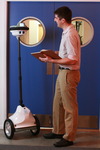Would you consider using an office robot to telecommute? -WSJ poll
I’m a definite “yes”! As a remote worker, I know that getting in face time and making myself seem “real” and personable to coworkers is crucial. In fact, studies show that workers who put in less “face time” are less likely to be credited for working as hard as the one who does. Studies also show that seeing and interacting with team members in their regular work environment is a big factor in improving virtual team relationships. So anything that boosts my presence and improves my work relationships sounds good to me, even if it means being a telecommuting robot.
But just how much “presence” and work context does a $9700 proxy robot give you? Over the summer, WSJ reporter Rachel Silverman has been trying out one of these QB-82s (by Anybot, Inc) from her home office and tells of her experiences as a telecommuting robot:
“The robot made me feel closer to distant colleagues…. During my robot days, I interacted with co-workers I’d never met before, as well as others I hadn’t talked with in years; each of them was compelled to greet me as I cruised down the hall. I chitchatted at the office coffee bar, a more lively scene than sipping coffee alone in my kitchen.
…People connected with Robot Rachel, whose friendly mien was hard to resist…. I even chatted with the Journal’s top editor at the daily morning-news meeting, which never happened before from my desk in Texas.”
Silverman shares that another QB user, Faith Brady at Elance Inc, is even able to fulfill her receptionist duties from across the country in Illinoise, greeting guests and offering them a drink at the company’s location in Mountain View, California.
Research with telepresence robots also has also proved to be very positive. Cisco researchers found that people tended to be “more honest and open” with robot proxies than with human colleagues. Microsoft researchers led by Gina Venolia found that they improved work relationships. A previous VSee blog post sums it up:
Remote workers…felt like they were more connected to the team and able to participate more fully in office life. Their coworkers felt more familiar and friendly towards their remote counterparts and were able to interact with them in a more physical way, which also made them seem more real, especially those they had never met in person.
Of course, with all the time consuming technical glitches Silverman and WSJ staff faced, it doesn’t look like the world of Star Wars or Buck Rogers is right around the corner. Besides, robot proxies only work if you’ve got a few telecommuters. What if you’re running a virtual office or an office where the majority of people are away from their desks on any given day? In many cases, videoconferencing is still the way to go. With more and more people working “flexibly,” video is becoming an essential work tool and not just an amusing diversion. Versatile desktop video solutions like VSee abound the market these days, so it’s now easier than ever to find something that fits your remote work needs!
Related articles:
- Beam Me Up Remote Worker (WSJ blog) – how companies are connecting far flung employees through technology and design
- Botting from the boss’s perspective (WSJ) – Silverman’s editor comments from the other side of the QB experience
- [My Life As A Telecommuting Robot] video
- Why Showing Your Face At Work Matters (MIT Sloan) – article by the researchers themselves
Follow us on Twitter (@VSee) and Like us on Facebook to hear about the latest from VSee!
photo courtesy: Anybots, Inc.




